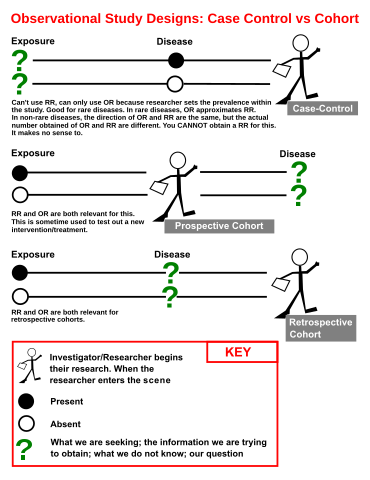Observational study design#

Case-control study#
Case-Control studies are usually but not exclusively retrospective, the opposite is true for cohort studies. The following notes relate case-control to cohort studies:
outcome is measured before exposure
controls are selected on the basis of not having the outcome
good for rare outcomes
relatively inexpensive
smaller numbers required
quicker to complete
prone to selection bias
prone to recall/retrospective bias
related methods are risk (retrospective), chi-square 2 by 2 test, Fisher’s exact test, exact confidence interval for odds ratio, odds ratio meta-analysis and conditional logistic regression.
Retrospective cohort study#
A retrospective study looks backwards and examines exposures to suspected risk or protection factors in relation to an outcome that is established at the start of the study. Many valuable case-control studies, such as Lane and Claypon’s 1926 investigation of risk factors for breast cancer, were retrospective investigations. Most sources of error due to confounding and bias are more common in retrospective studies than in prospective studies. For this reason, retrospective investigations are often criticised. If the outcome of interest is uncommon, however, the size of prospective investigation required to estimate relative risk is often too large to be feasible. In retrospective studies the odds ratio provides an estimate of relative risk. You should take special care to avoid sources of bias and confounding in retrospective studies.
Prospective investigation is required to make precise estimates of either the incidence of an outcome or the relative risk of an outcome based on exposure.
Prospective cohort study#
A prospective study watches for outcomes, such as the development of a disease, during the study period and relates this to other factors such as suspected risk or protection factor(s). The study usually involves taking a cohort of subjects and watching them over a long period. The outcome of interest should be common; otherwise, the number of outcomes observed will be too small to be statistically meaningful (indistinguishable from those that may have arisen by chance). All efforts should be made to avoid sources of bias such as the loss of individuals to follow up during the study. Prospective studies usually have fewer potential sources of bias and confounding than retrospective studies.
